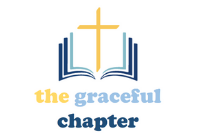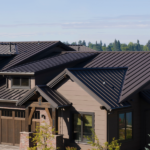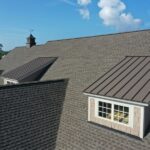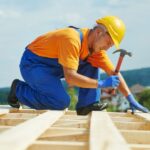The roof is the crown of a building, and it maintains the safety, integrity, and overall well-being of the structure. By being constantly subjected to the elements, it’s susceptible to wear and tear over time. In this article, we explore the various indicators that signal a roof in distress.

Interior Water Stains and Leaks
These marks may appear on your ceilings or walls, being telltale signs of leaks during bouts of rainfall. If water infiltrates the roofing system, it can lead to structural damage, mold growth, and compromised insulation.
People should conduct regular inspections – especially after heavy rains – to discern any discoloration or dampness. It’s paramount to address water stains promptly as it prevents further damage, and keeps the indoor environment safe and healthy.
Damaged or Missing Shingles
Shingles are a building’s armor, but they take the brunt of the harsh weather elements. Damaged, curling, or missing shingles expose the vulnerable underbelly of the structure. This leaves it susceptible to leaks and further deterioration. Pay attention to irregularities in the shingle pattern, as significant damage or missing sections may necessitate professional intervention.
Timely repairs or replacements can salvage the integrity of the roof. This can prevent a cascade of issues that could lead to more substantial damages. You may be a resident of an independent city in Virginia, USA. The people who need a new roof in Chesapeake go online to discover expert installers, affordable prices, and premium products. They check the Google and Facebook reviews, note the contact details, and request free quotes.
Sagging Roof Deck
This phenomenon may arise from water damage, rotting, or weakened structural components. Inside the attic, keen eyes should be on the lookout for noticeable dips or sagging areas.
A sagging roof deck is more than a cosmetic concern. It speaks to the structural integrity of the entire building. Swift action is imperative, so consult with a roofing professional quickly. They’ll assess the extent of the damage and prescribe the necessary repairs. Ignoring a sagging roof deck can lead to more severe structural problems. In turn, this could jeopardize the safety of the occupants.

Granule Loss
The granules adorning asphalt shingles protect them from the sun’s relentless UV rays. Over time, they may wear off, particularly on aging roofs. A cursory inspection of the gutters can reveal the state of the shingles. An accumulation of granules here indicates potential shingle deterioration.
Granule loss accelerates the aging process of the roof and compromises its ability to withstand weather elements. You should regularly monitor granule loss and promptly address the situation when required. This can extend the life of the roof and avert more significant issues later on.
Clogged or Overflowing Gutters
Gutters play an indispensable role in directing water away from the roof and the foundation of the building. Clogged or overflowing gutters impede the natural flow of water. This causes it to pool on the roof and potentially seep into the structure.
Regular inspections and gutter cleaning are essential to ensure proper water drainage. Overflowing water or pools near the foundation should raise immediate concerns. Addressing gutter issues promptly preserves the integrity of the roof and protects the foundation from potential water-related damages.
Related Posts
Daylight Penetrating Through the Roof
If daylight shines through the roof into the attic or living spaces, it raises a significant cause for concern. This phenomenon indicates a potential breach in the roofing system – whether through gaps, cracks, or compromised seals.
An attic inspection during daylight hours can reveal areas where sunlight is visible. Identifying these points of penetration early allows for timely repairs. This prevents water intrusion, heat loss, and other issues associated with a compromised roof.

Mold or Mildew Growth
Mold or mildew growth on the interior or exterior of a building is a clear indicator of a compromised roof. Moisture creates an environment conducive to mold proliferation, and a failing roof provides the gateway for its entry.
Regular inspections of the attic and ceilings are crucial to detect signs of mold, mildew, or musty odors. It’s vital to address the underlying roof issues and ensure proper ventilation. In turn, you can mitigate the risk of mold growth. Mold poses health risks and accelerates the deterioration of building materials, underscoring the importance of swift action.
Identifying the signs of a failing roof can save homeowners and property managers from extensive and costly repairs. Regular inspections should be conducted, both inside and outside the building. Timely repairs and maintenance can extend the lifespan of the roof and safeguard the well-being of the occupants.






Some sagging has been happening quite a lot to our house’s roof recently, and I really want to do something about that. I think this is exactly the kind of thing we should try solve when the weather calms down so that we can avoid any kind of dangerous risks and dangers to our home. I’ll go and look for a roofer in the area so they can help us out with some repairs right away.